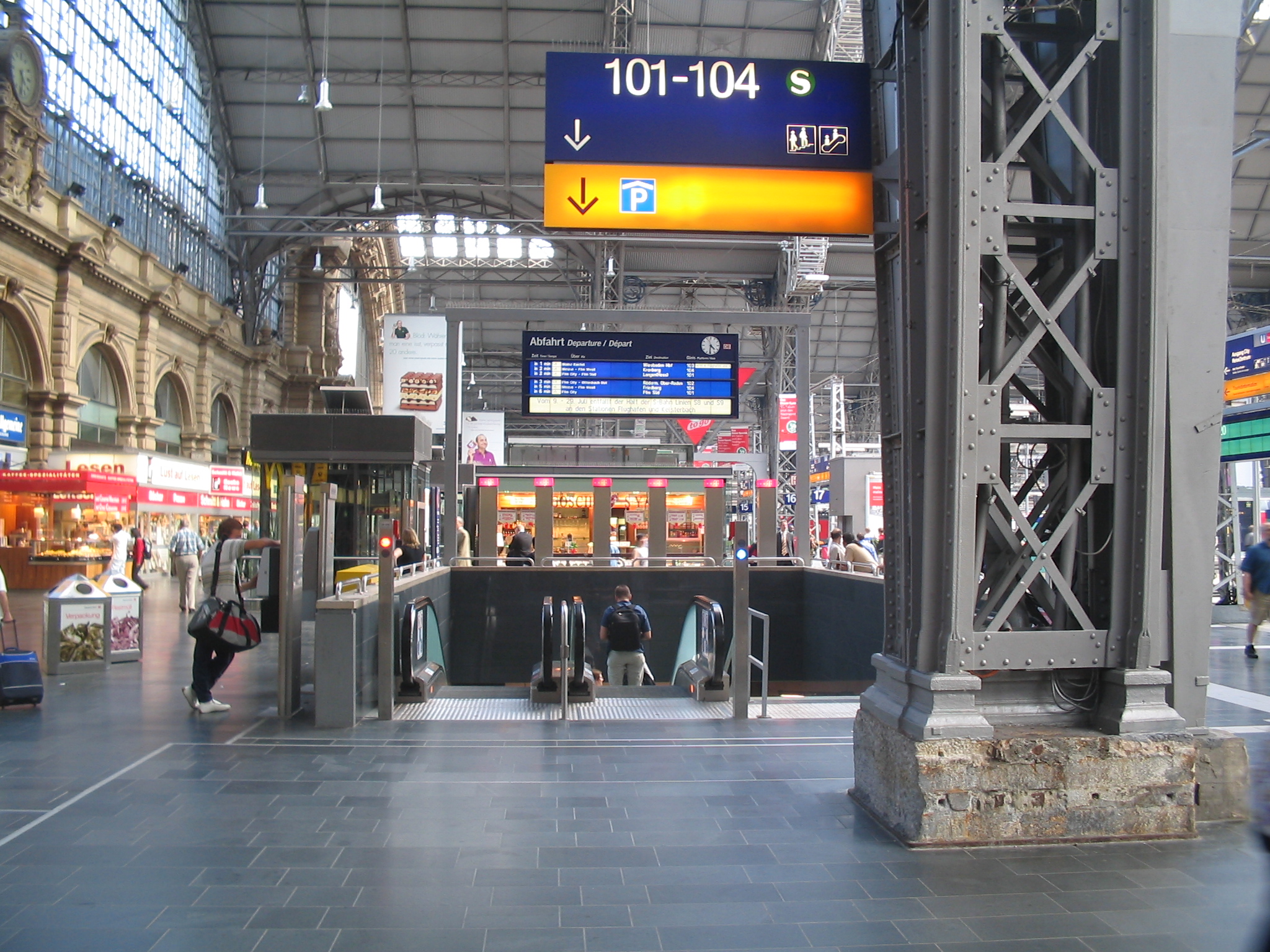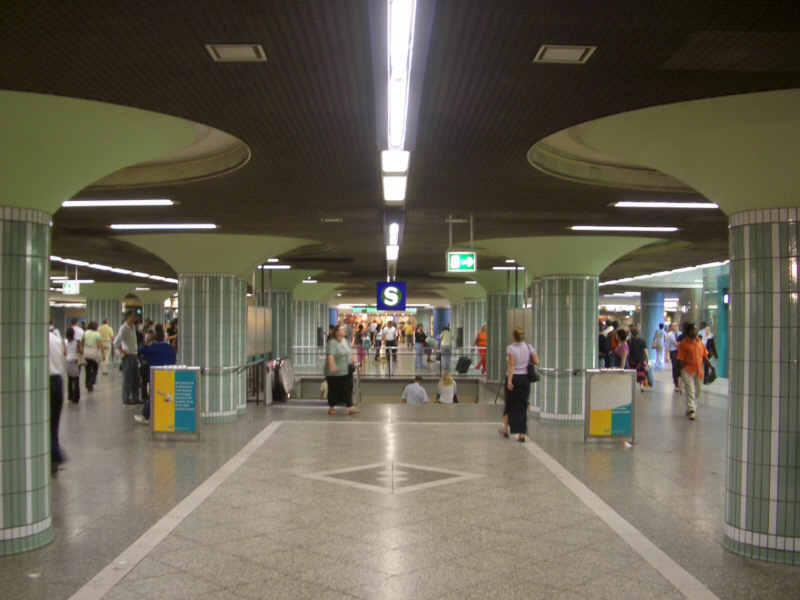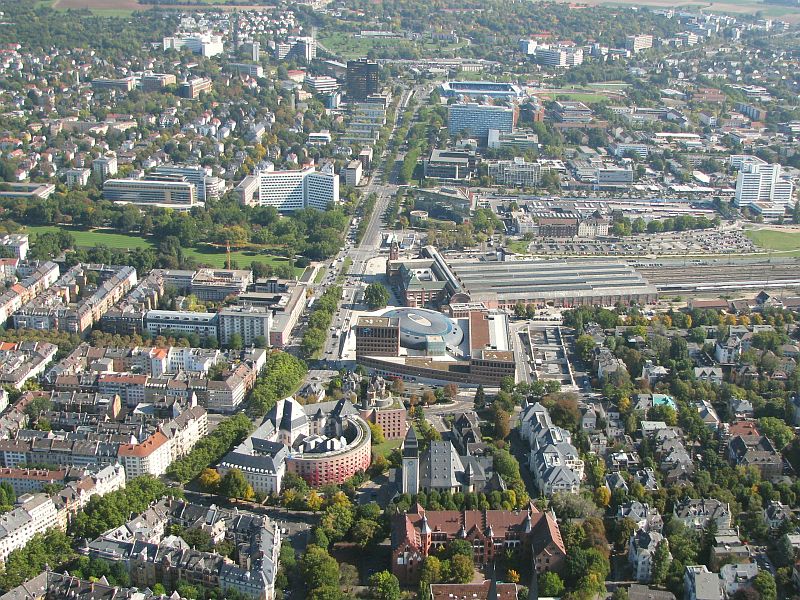|
Frankfurt Central Underground Station
Frankfurt (Main) Hauptbahnhof (low level) ( German: ''Frankfurt (Main) Hauptbahnhof Tiefbahnhof'', officially ''Frankfurt (Main) Hbf (tief)'') is a four-track S-Bahn station below Frankfurt (Main) Hauptbahnhof and as such part of the busiest railway station in Frankfurt, Germany. It is also the busiest rapid transit station in Frankfurt. The underground station forms together with Hauptwache station and Konstablerwache station the key nodes in the network of the Rhine-Main S-Bahn, a rail network that serves the Frankfurt/Rhine-Main region. It connects with the surface platforms of regional and long-distance services and also interchanges with the U-Bahn and trams. Station The underground station is located under the northern part of Frankfurt central station and its forecourt in the Gutleut district, west of central Frankfurt. The station is part of the City Tunnel line. Located above the S-Bahn station is the U-Bahn station, which was built at the same time. The station con ... [...More Info...] [...Related Items...] OR: [Wikipedia] [Google] [Baidu] |
S6 (Rhine-Main S-Bahn)
The S6 service of the S-Bahn Rhein-Main system bearing the KBS (German scheduled railway route) number 645.6 Routes Main-Weser Railway City tunnel The city tunnel is an underground, pure S-Bahn route used by almost all services (except for the S7 service which terminates at the central station). In a short section between Mühlberg and Offenbach-Kaiserlei the South Main railway is used. History The S6 was one of the first six services of the Rhine-Main S-Bahn system. In a prior test operation it ran between Kronberg and Frankfurt Central Station. The service was then called R6 where the letter "R" stands for regional. After the opening of the Frankfurt Citytunnel the service was renamed to S6 and extended to the new Hauptwache underground station. Further extensions of the tunnel followed in 1983 (Konstablerwache) and 1990 (Ostendstraße and Lokalbahnhof) so that Stresemannallee became the service's eastern terminal. Operation # Friedberg – Frankfurt Süd # ... [...More Info...] [...Related Items...] OR: [Wikipedia] [Google] [Baidu] |
Frankfurt Hauptwache Station
Frankfurt (Main) Hauptwache station (german: link=no, Bahnhof Frankfurt (Main) Hauptwache) is a major train station in the city centre of Frankfurt, Germany. With 181,000 passengers per day, Hauptwache station is the third-busiest rapid transit station in Frankfurt after Frankfurt Central Station and Konstablerwache station and a major hub for commuter transport in the Frankfurt/Rhine-Main region. It is served by eight S-Bahn lines (S1–S6, S8, S9) and six U-Bahn lines (U1-U3, U6-U8) on 2 levels. Name The underground station is named after a baroque building which stands on a plaza above the station. The Hauptwache building was constructed in 1730 and was used as a prison, therefore the name that translates as "main guard-house". Today the square surrounding the building is also called "Hauptwache" (formal: ''An der Hauptwache''). Location Hauptwache station is situated at the western end of Frankfurt's main shopping street, the Zeil. Konstablerwache station is located at th ... [...More Info...] [...Related Items...] OR: [Wikipedia] [Google] [Baidu] |
Darmstadt Hbf
Darmstadt Hauptbahnhof is the main railway station in the German city Darmstadt. After Frankfurt Hbf and Wiesbaden Hbf, it is the third largest station in the state of Hesse with 35,000 passengers and 220 trains per day. Built in a late art nouveau style, the station was finished 1912 as one of the major works of architect Friedrich Pützer. The station replaced two separate and increasingly inadequate stations located at the ''Steubenplatz'', around a km closer to the city centre in the east. History The predecessors of Darmstadt Hauptbahnhof were two separate stations in today's , which were built by two railway companies in the 19th century when Darmstadt was connected to the rail network: the Main-Neckar station, a through station on the Frankfurt–Heidelberg line, opened in 1846, and the Ludwig station, a terminal station on the Mainz–Aschaffenburg railway, opened in 1858. The space at both stations became very cramped as a result of the increase in traffic at the en ... [...More Info...] [...Related Items...] OR: [Wikipedia] [Google] [Baidu] |
Bad Soden Station
Bad Soden (Taunus) station is the northern terminus of the Soden Railway (german: Sodener Bahn) in the German state of Hesse. It is also the northern terminus of line S3 of the Rhine-Main S-Bahn over the Limes Railway (''Limesbahn''). Location and facilities The station is located in the centre of Bad Soden. The entrance building was built in 1847 and the middle part of the building dates from this time. The southern gable of the northern wing and the attached sheds were added in the second decade of the last century. The entrance building is listed as a monument under the Hessian Heritage Act. Next to the platform, there was a long freight shed with its own sidings. These facilities have been removed in the last few years. History The station was opened on 22 May 1847 as the terminus of the Soden Railway. This joined Soden with the nearest large town, Höchst, where it connected with the Taunus Railway from Frankfurt to Wiesbaden opened in 1839. The line and associated work ... [...More Info...] [...Related Items...] OR: [Wikipedia] [Google] [Baidu] |
Dietzenbach Station
Dietzenbach station (''Dietzenbach Bahnhof'') is the terminus of the Offenbach-Bieber–Dietzenbach railway in the German state of Hesse. The station is now used exclusively by line S2 of the Rhine-Main S-Bahn. The entrance building is protected as a monument. The station is classified by Deutsche Bahn as a category 5 station. History Dietzenbach station was established on 1 December 1898 together with the opening of the Offenbach-Bieber–Dietzenbach railway, a branch line of the Rodgau Railway (german: Rodgaubahn). From the beginning all passenger services on the line started here. Labourers and craftsmen used the line to commute to their jobs in Offenbach am Main and Frankfurt and local farmers benefited from having faster transportation to the markets of the major cities. Traffic to Dietzenbach flourished in the period after the Second World War. In 1959 there were still 25 daily trains to Offenbach, but in 1978 there were only five. On 18 June 1982, passenger services w ... [...More Info...] [...Related Items...] OR: [Wikipedia] [Google] [Baidu] |
Niedernhausen Station
Niedernhausen station serves the municipality of Niedernhausen in the German state of Hesse. It is the most important station on the Main-Lahn Railway between the stations of Frankfurt-Höchst and Eschhofen in Limburg an der Lahn. It is the terminus of the Ländches Railway running from Niedernhausen to Wiesbaden Hauptbahnhof and of line S2 of the Rhine-Main S-Bahn from Frankfurt. History Niedernhausen station was opened by the Hessian Ludwig Railway (german: Hessische Ludwigsbahn) with the Main-Lahn Railway (''Main-Lahn-Bahn'') from Frankfurt to Limburg in 1877. The last section of the route between Frankfurt-Höchst and Idstein was opened on 15 October 1877. This completed the link between the Rhine-Main area and the Limburg Basin. With the opening of the Ländches Railway (''Ländchesbahn'') between Niedernhausen and Wiesbaden in 1879, Niedernhausen became the main station between Höchst and Eschhofen in Limburg, where the Main-Lahn Railway connects with the Lahn Va ... [...More Info...] [...Related Items...] OR: [Wikipedia] [Google] [Baidu] |
Wiesbaden Hbf
Wiesbaden Hauptbahnhof is a railway station for the city of Wiesbaden, the state capital of the German state of Hesse. It is a terminal station at the southern edge of the city centre and is used by more than 40,000 travelers each day, so it is the second largest station in Hesse after Frankfurt Hauptbahnhof. It is classified by Deutsche Bahn as a category 2 station. History The current station replaced three stations in the city centre, which were next to each other near the fairground (''Rhein-Main-Hallen'') and the Wiesbaden Museum. These were: *The Taunusbahnhof (Taunus station), built in 1840 for the Taunus Railway (Wiesbaden– Castel– Höchst– Frankfurt (Taunusbahnhof). *The Rheinbahnhof (Rhine station), built in 1857 for the East Rhine railway (Wiesbaden– Biebrich– Rüdesheim–Niederlahnstein). *The Ludwigsbahnhof ( Ludwig's Railway station), built in 1879 for the Ländches Railway (Wiesbaden-Niedernhausen). A fourth railway line was added in 1889, conne ... [...More Info...] [...Related Items...] OR: [Wikipedia] [Google] [Baidu] |
U-Bahn Line B (Frankfurt U-Bahn)
The U-Bahn Line B is the second line in the network of the Frankfurt U-Bahn. It leads in west–east direction from the central railway station (''Hauptbahnhof'') over the old town to Konstablerwache, where it splits into two branches to Bornheim (U4 service) and Preungesheim (U5 service). Originally planned as an independent main line, the D line represents an extension of the U4 to Bockenheimer Warte from the central railway station. The northern branch to Preungesheim was opened in 1974 and was used by the B1 service, and since May 1978 by U5. A large part of the route consists of a former tram line, which runs in Eckenheimer highway on street-level railway track. The platforms were also very low on the parts of the track, meaning that only the converted Ptb trams could run on the line. From 2013 to 2016, the above ground stations were developed barrier-free. Since 9 October 2016 the subway cars type U5 run on the U5 service. Inaugurated in 1980, the U4 runs between Bockenheim ... [...More Info...] [...Related Items...] OR: [Wikipedia] [Google] [Baidu] |
Gutleutviertel (Frankfurt Am Main)
The Gutleutviertel is a quarter of Frankfurt am Main, Germany. It is part of the ''Ortsbezirk Innenstadt I''. The name ''Gutleut'' originates from the "Gutleuthof", once a refuge for lepers hosted by the "fraternity A fraternity (from Latin ''frater'': "brother"; whence, " brotherhood") or fraternal organization is an organization, society, club or fraternal order traditionally of men associated together for various religious or secular aims. Fraternit ... of the good people". The former working class district has spruced up considerably in recent years with the development of a new housing and business district at the former West Harbor. References Districts of Frankfurt {{Hesse-geo-stub ... [...More Info...] [...Related Items...] OR: [Wikipedia] [Google] [Baidu] |
Frankfurt Hauptbahnhof Downstairs To S-Bahn 0287
Frankfurt, officially Frankfurt am Main (; Hessian: , "Frank ford on the Main"), is the most populous city in the German state of Hesse. Its 791,000 inhabitants as of 2022 make it the fifth-most populous city in Germany. Located on its namesake Main River, it forms a continuous conurbation with the neighboring city of Offenbach am Main and its urban area has a population of over 2.3 million. The city is the heart of the larger Rhine-Main metropolitan region, which has a population of more than 5.6 million and is Germany's second-largest metropolitan region after the Rhine-Ruhr region. Frankfurt's central business district, the Bankenviertel, lies about northwest of the geographic center of the EU at Gadheim, Lower Franconia. Like France and Franconia, the city is named after the Franks. Frankfurt is the largest city in the Rhine Franconian dialect area. Frankfurt was a city state, the Free City of Frankfurt, for nearly five centuries, and was one of the most importan ... [...More Info...] [...Related Items...] OR: [Wikipedia] [Google] [Baidu] |
Trams In Frankfurt Am Main
The Frankfurt am Main tramway network is a network of tramways forming a major part of the public transport system in Frankfurt am Main, a city in the federal state of Hesse, Germany. , there were 10 tram lines, along with two special lines and one heritage tourist tramline. The network was also heavily integrated into the Frankfurt U-Bahn, with the systems sharing both street running and reserved track. In 2012, the network had 136 stations, and a total route length of . In the same year, the network carried 49.9 million passengers, about 30% of total public transport ridership in Frankfurt. History The network is the oldest light rail system in the city, the first horse tram lines having started operations on 19 May 1872. It includes one of the first electric tramways in the world, with the first electrified tram line starting in 1884. Frankfurt Trambahn-Gesellschaft The Frankfurt Trambahn-Gesellschaft (FTG), founded in 1872 as a subsidiary of the Brussels-based company ... [...More Info...] [...Related Items...] OR: [Wikipedia] [Google] [Baidu] |
Frankfurt U-Bahn
The Frankfurt U-Bahn is a Stadtbahn system serving Frankfurt, Hesse, Germany. Together with the Rhine-Main S-Bahn and the Frankfurt Straßenbahn, it forms the backbone of the public transport system in Frankfurt. Its name derives from the German term for underground, ''Untergrundbahn''. Since 1996, the U-Bahn has been owned and operated by (VGF), the public transport company of Frankfurt, and is part of the Rhein-Main-Verkehrsverbund (RMV) transport association. The licence contract is up to 31 December 2031 and is renewable. The contracting authority of VGF is the municipal transport company . The U-Bahn opened in 1968, and has been expanded several times. It consists of three inner-city tunnels and above-ground lines in the suburbs. About 59% of the track length is underground. The network operates in a variety of right of ways typical of a light rail system, with above-ground sections operating on street and core sections running underground in the inner city. Like a ... [...More Info...] [...Related Items...] OR: [Wikipedia] [Google] [Baidu] |





.png)
